Thyroid Nodules: Distinguishing AFFF-Related Cases
We grasp the intricacies involved in distinguishing thyroid nodules related to AFFF exposure. Most thyroid nodules are benign, but AFFF exposure, rich in PFAS chemicals, heightens the risk for severe thyroid conditions, including cancerous nodules. Fine-needle aspiration biopsy and ultrasound are critical in assessing these risks, with sonographic criteria helping to evaluate malignancy. Firefighters, exposed to AFFF, face an elevated thyroid health risk, requiring specialized medical and legal support. Specialized attorneys assist in managing these cases, ensuring thorough documentation and presentation of evidence for compensation. For those affected, understanding legal rights and compensation avenues is essential, providing a clear path forward for affected individuals.
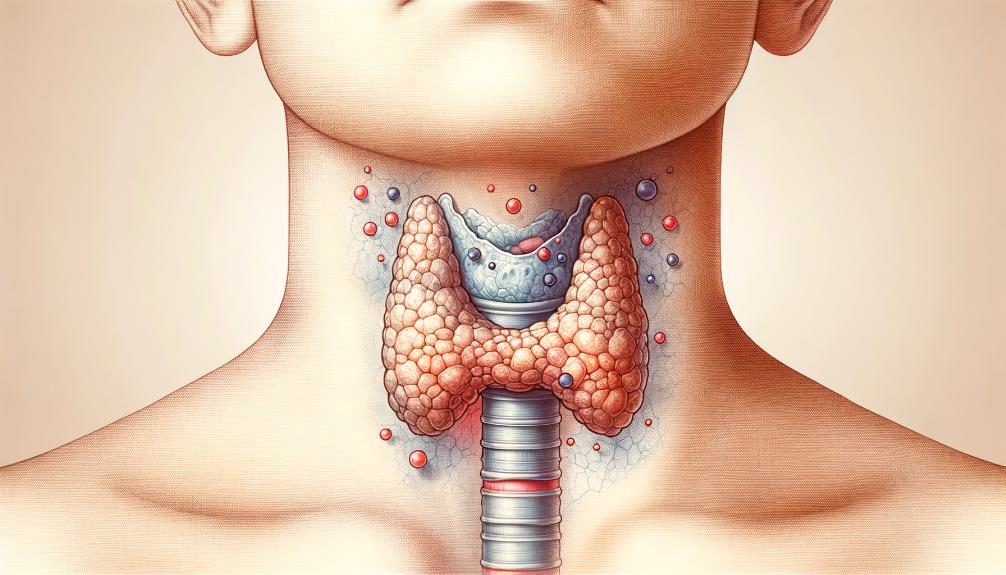
Key Takeaways
- AFFF exposure in firefighters is linked to an increased risk of developing thyroid nodules due to PFAS chemicals.
- Chronic AFFF exposure exacerbates the risk of thyroid dysfunction, making duration and intensity pivotal in distinguishing cases.
- Diagnostic approaches such as fine-needle aspiration biopsy and duplex power Doppler ultrasound are essential in evaluating AFFF-related thyroid nodules.
- Symptoms like a gradually enlarging lump and discomfort when swallowing may indicate AFFF-related thyroid nodules in high-risk individuals.
- Legal support for AFFF-related thyroid cases relies on thorough documentation of exposure and its impact on thyroid health.
Understanding Thyroid Nodules
Thyroid nodules are lumps that can form in your thyroid gland, and while most are benign, it's important to understand their nature and implications. We're aware that these nodules are quite common, especially in women, and the good news is that the majority don't pose a significant health risk. However, distinguishing between benign and potentially cancerous nodules is essential for effective management and treatment.
To assess the malignancy risk of thyroid nodules, diagnostic tools like fine-needle aspiration biopsy and ultrasound are indispensable. It's noteworthy that the size of a nodule isn't a reliable indicator of cancer risk. This fact underscores the importance of fine-needle aspiration biopsy, which provides a more accurate assessment through a minimally invasive procedure.
Moreover, sonographic criteria play a pivotal role in evaluating thyroid nodules. Features such as irregular edges and solid hypoechogenicity are red flags that may indicate a higher risk of malignancy. These criteria help in making informed decisions regarding further diagnostic evaluations or interventions.
Management guidelines for thyroid nodules and cancer emphasize the use of ultrasound and fine-needle aspiration cytology in the evaluation process. These guidelines aim to streamline the diagnosis and treatment, ensuring that individuals receive the most appropriate care based on the characteristics of their nodules.
Causes Behind Thyroid Nodules
We're now turning our attention to the underlying reasons for thyroid nodules, particularly focusing on nodule formation factors and the impact of iodine deficiency. It's important to understand these reasons, as they play a vital role in the development and progression of thyroid nodules. By examining these aspects, we can better distinguish AFFF-related cases and guarantee accurate diagnosis and treatment.
Nodule Formation Factors
Understanding the causes behind thyroid nodules is essential, as they can range from benign overgrowths to more serious conditions like cancer. Thyroid nodules can form due to a variety of reasons, including the overgrowth of normal thyroid tissue, fluid-filled cysts, benign or malignant tumors, and inflammation such as Hashimoto's disease. The majority of these nodules are benign, making the consideration of malignancy critical for proper evaluation and management. Symptoms often remain unnoticed until they present as a gradually enlarging lump or cause discomfort when swallowing. Given that thyroid nodules are more common in women, the clinical evaluation by a physician is paramount to monitor for potential malignancy, ensuring that appropriate diagnostic and management strategies are implemented effectively.
Iodine Deficiency Impact
Iodine deficiency greatly contributes to the development of thyroid nodules, highlighting the importance of adequate dietary intake for thyroid health. Without sufficient iodine, our thyroid gland struggles to produce the necessary thyroid hormones, leading to various health issues, including the formation of nodules. Insufficient iodine intake doesn't just affect hormone production; it also can cause the thyroid gland to enlarge, a condition known as goiter, which further worsens nodule formation. Addressing iodine deficiency is, hence, essential in the prevention and management of thyroid nodules. By ensuring we're getting enough iodine in our diet, we're taking a significant step towards maintaining our thyroid health and reducing the risk of nodule formation.
Symptoms and Signs
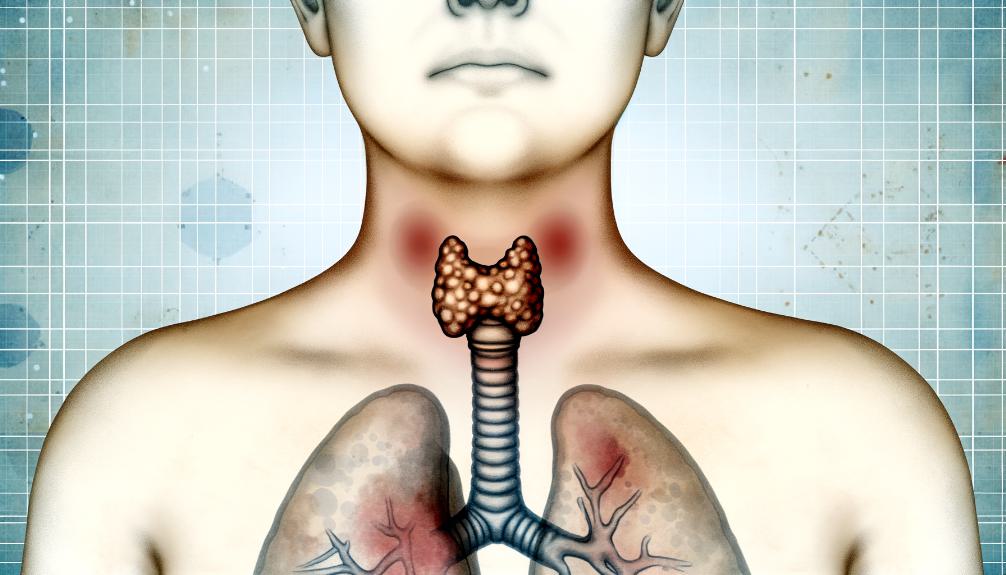
As we progress in our discussion, it's essential that we examine the common symptoms associated with thyroid nodules from AFFF exposure, including a noticeable lump in the neck and discomfort when swallowing. Understanding these signs is critical for early detection, which is paramount in managing the condition effectively. Additionally, we'll explore the methods employed in identifying these nodules, emphasizing the importance of vigilance among those with potential AFFF exposure.
Common Symptom Overview
Why should we be concerned about thyroid nodules? Common symptoms include a gradually enlarging neck lump and discomfort when swallowing. We often hear about thyroid nodules being crucial, but when symptoms like neck lumps, especially in women, and hoarseness appear, it's a clear signal that we need to take action. These symptoms aren't just discomforting; they're our body's way of urging us to seek evaluation. Consulting a physician is vital not only to rule out malignancy but also to determine the necessary steps for monitoring and management. Understanding the significance of keeping an eye on nodule size and recognizing risk factors for malignancy is essential. It aids in the early detection and treatment of thyroid nodules, ensuring our health isn't compromised.
Nodule Detection Methods
To effectively identify thyroid nodules, we must be aware of both the subtle and overt symptoms and signs that can signal their presence. Often, thyroid nodules are discovered incidentally during routine exams or imaging for unrelated issues. Symptoms like a painless lump in the neck, difficulty swallowing, hoarseness, or voice changes are common. Additionally, an enlarged thyroid or a palpable nodule might be found on physical examination. Diagnostic tools such as ultrasound, fine-needle aspiration biopsy, and thyroid scans are crucial for nodule detection and characterization. Early detection and monitoring are essential to evaluate the risk of malignancy and decide on the best course of action. Utilizing these diagnostic tools ensures thorough monitoring and aids in the effective management of thyroid nodules.
Diagnostic Approaches
The assessment of thyroid nodules often relies on the precision of diagnostic approaches, among which fine-needle aspiration biopsy stands out as a vital tool. This technique is indispensable for evaluating the risk of malignancy in thyroid nodules, providing critical information that guides further management. We've found that ultrasound-guided fine-needle aspiration biopsy is effective regardless of nodule size, ensuring that even the smallest of nodules can be accurately assessed.
Furthermore, the significance of cytohistologic correlation cannot be overstated in our diagnostic arsenal. By comparing cytologic findings from biopsy samples with histologic findings, we're able to refine our understanding of each nodule's nature. This correlation is essential for confirming the presence or absence of malignancy, guiding us toward the most appropriate management strategies.
Recent advancements in sonographic criteria have also enhanced our ability to recommend fine-needle aspiration biopsy for nonpalpable solid nodules. These criteria help in identifying nodules that warrant further investigation, streamlining the diagnostic process.
Additionally, we've incorporated duplex power Doppler ultrasound into our diagnostic approaches. This tool plays a significant role in differentiating between malignant and benign thyroid nodules. By analyzing blood flow patterns within the nodule, we're able to gather more information that can hint at malignancy, thereby improving our diagnostic accuracy.
Treatment Options Explored

Several treatment options, including surgical intervention, radioactive iodine therapy, and hormone suppression, are available for managing thyroid nodules linked to AFFF exposure. We've observed that these approaches, when tailored to individual cases, can greatly improve outcomes for those affected. Moreover, strategies aimed at reducing AFFF exposure are vital. By advocating for the use of protective gear and pushing for regulatory changes that promote PFAS-free suppressants, we're not just treating thyroid nodules; we're preventing their occurrence.
In light of evidence-based analysis, it's clear that stringent regulatory measures and proactive health surveillance play pivotal roles in the management of AFFF-related thyroid nodules. These measures are essential for early detection, timely intervention, and ultimately, a favorable prognosis. The advancements in treatment options over the years have undeniably enhanced the quality of life for individuals with these conditions.
Longitudinal studies and health monitoring protocols have become cornerstones in our fight against the impact of AFFF on thyroid health. These initiatives provide us with invaluable insights into the progression of thyroid nodules and the effectiveness of various treatment modalities. It's through such rigorous monitoring that we're able to refine our approach, ensuring that individuals exposed to AFFF receive the best possible care.
The journey toward managing thyroid nodules, especially those related to AFFF exposure, is complex. However, with the right treatment options, protective measures, and regulatory oversight, we're making significant progress. Our efforts in health surveillance are paving the way for improved prognosis and, ultimately, better health outcomes for those affected.
AFFF Exposure Overview
A substantial number of individuals, particularly firefighters, face heightened thyroid health risks due to their exposure to AFFF, which contains harmful PFAS chemicals. These substances, known for their resistance to degradation, contribute not only to environmental contamination but also elevate the risk of thyroid disorders among those exposed. It's vital to understand the gravity of this situation, as the thyroid plays a pivotal role in regulating our body's metabolism through hormone production.
Firefighters, both in military and civilian roles, are at the forefront of this risk, frequently coming into contact with AFFF during firefighting activities. Their chronic exposure to PFAS has been linked to a higher prevalence of severe thyroid conditions, including hypothyroidism and thyroid cancer. This correlation highlights the need for heightened vigilance and preventive measures within this group.
The exposure to PFAS from AFFF disrupts the delicate balance of the endocrine system, specifically targeting the thyroid gland. This gland is essential for producing hormones that regulate numerous bodily functions, making its susceptibility to PFAS particularly concerning. The inherent risk posed by these chemicals to thyroid health underscores the urgency in addressing AFFF-related exposures and their long-term effects.
Given these facts, it's apparent that the exposure to PFAS through AFFF is a significant health concern, especially for those in high-risk professions. Understanding the mechanisms through which PFAS affect the thyroid and the resulting health implications is critical in developing strategies to mitigate these risks and protect those most vulnerable to exposure.
PFAS and Thyroid Impact
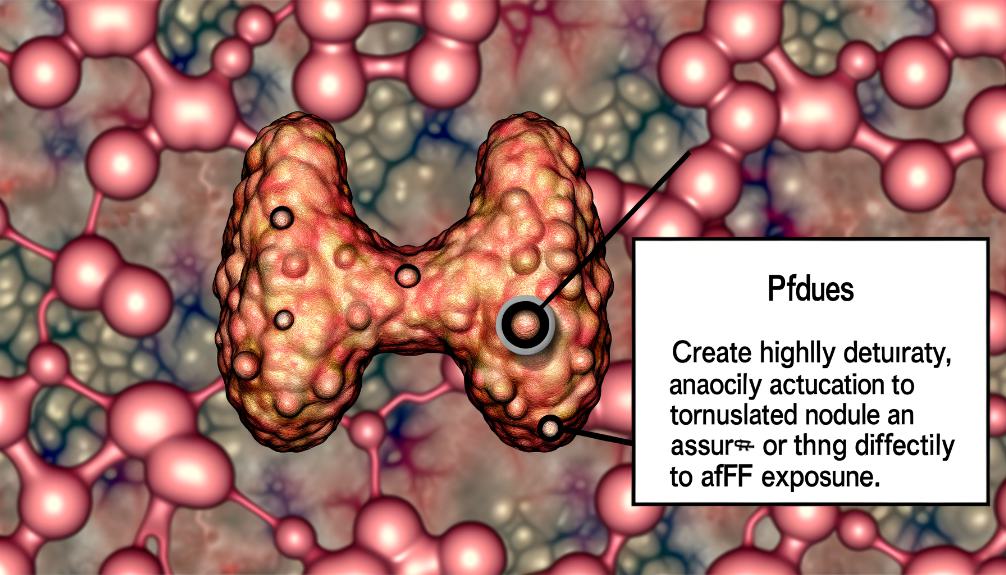
Why should we be concerned about PFAS in AFFF impacting our thyroid health? PFAS chemicals, found in Aqueous Film Forming Foam (AFFF), are notorious for disrupting the delicate hormone balance essential for thyroid function. These substances have been linked to an increased risk of thyroid disorders, making it imperative for us to understand their effects. PFAS act as endocrine disruptors, meaning they interfere with our body's hormone systems, including those governing thyroid health. This disruption can lead to significant health issues, including thyroid nodules, a precursor to more severe conditions.
The impact on thyroid health from AFFF exposure is significant. PFOA, a specific type of PFAS found in AFFF, inhibits iodine accumulation in the thyroid gland. Iodine is vital for thyroid hormone production, and its inhibition raises the likelihood of developing thyroid cancer. Additionally, chronic exposure to AFFF leads to altered thyroid hormone levels and may have cytotoxic effects on thyroid cells. This alteration in hormone levels further underscores the significant impact AFFF exposure has on our thyroid health.
Firefighters, due to their occupational exposure to AFFF, face an elevated risk of thyroid disease due to the toxic PFAS chemicals present. The association between PFAS exposure and thyroid disease is clear, and the health implications are concerning. It disrupts thyroid function and is associated with the development of thyroid nodules, highlighting the need for increased awareness and preventive measures to protect those at risk. As we continue to understand the full scope of PFAS's impact on thyroid health, it's vital to address the risks associated with AFFF exposure.
Firefighters Risk Analysis
Understanding the effects of PFAS in AFFF on thyroid health leads us to examine the specific risks firefighters face. Our analysis reveals that both military and civilian firefighters who have been exposed to AFFF are at an heightened risk of developing various thyroid diseases. The presence of PFAS chemicals in AFFF is known to disrupt the thyroid hormone system, which is vital in regulating metabolism, energy generation, and overall hormonal balance. This disruption leads to an elevated prevalence of thyroid disorders among firefighters, including hypothyroidism and thyroid cancer.
Moreover, our risk analysis indicates that female firefighters are particularly vulnerable to thyroid disease following AFFF exposure. The chronic exposure to PFAS chemicals, known for their endocrine-disrupting capabilities, poses a significant health hazard to these professionals. It's evident that the link between AFFF exposure and thyroid nodules, alongside other thyroid-related conditions, necessitates a reevaluation of firefighting protocols and the implementation of enhanced safety measures.
To mitigate the risks associated with AFFF exposure, it's imperative that firefighting units adopt stringent health monitoring practices and safety protocols. These measures are vital for early detection and management of thyroid disease in firefighters. By addressing the direct correlation between AFFF exposure and the increased risk of thyroid disorders, we can better protect those who put their lives on the line to save others. Our commitment to safeguarding the health of firefighters must include a thorough approach to understanding and preventing the adverse effects associated with PFAS chemicals in AFFF.
Duration of AFFF Exposure
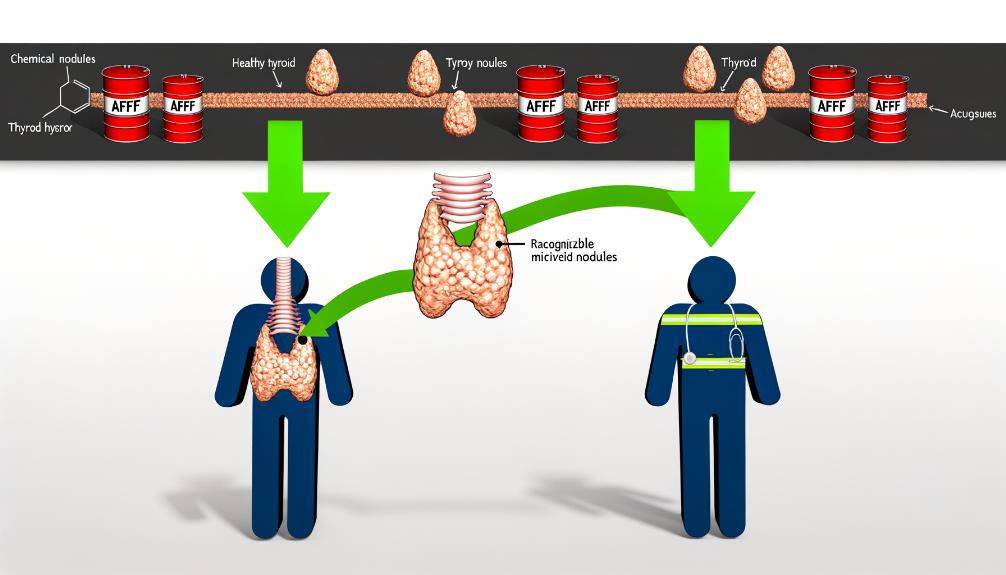
We're now turning our attention to the role that the length of AFFF exposure plays in the development of thyroid nodules, a critical aspect for evaluating health risks among affected individuals. It's evident that both the duration and intensity of contact with AFFF, which contains harmful PFAS chemicals, are crucial in understanding the potential for thyroid health impacts. This understanding is fundamental in guiding us toward more effective monitoring and preventive strategies for those at risk.
Exposure Length Impact
Regarding the duration of AFFF exposure, it's evident that longer exposure considerably increases the risk of developing thyroid disorders. We've found that the AFFF exposure length impact on thyroid health is profound, with thyroid nodules and thyroid dysfunction risks escalating significantly with prolonged exposure. Chronic exposure, in particular, has been shown to pave the way for thyroid disease development, underscoring the critical need to evaluate the long-term impacts of such exposure meticulously. The correlation between the length of exposure to AFFF and the likelihood of thyroid abnormalities cannot be overstated. It's clear that the longer individuals are exposed to AFFF, the greater the risk they face regarding thyroid disorder risks, highlighting the urgency of addressing this issue promptly.
Risk Factors Assessment
Evaluating the duration of AFFF exposure is essential in identifying the risk factors linked to thyroid nodules and related health issues. We've learned that chronic exposure to AFFF, which contains PFAS, greatly raises the risk of thyroid abnormalities, including nodules and cancer. The longer one's exposure, the higher the likelihood of experiencing detrimental effects on thyroid hormone synthesis. This correlation underscores the importance of thorough risk factors assessment in the medical diagnosis of thyroid conditions due to AFFF. Particularly, individuals with prolonged occupational exposure to AFFF should be meticulously evaluated. Understanding the direct link between exposure and thyroid health is vital for timely and accurate diagnosis, ultimately guiding effective treatment and prevention strategies for those affected by AFFF-related thyroid disorders.
Recognizing Cancer Symptoms
Identifying early signs of thyroid cancer, such as a neck lump and hoarseness, is crucial for prompt treatment. When we recognize the thyroid cancer symptoms, we're better equipped to act quickly, ensuring a timely healthcare provider consultation. This step is vital, especially for firefighters who've been exposed to Aqueous Film Forming Foam (AFFF), as the risk posed by this exposure isn't negligible. The presence of a neck lump or experiencing hoarseness shouldn't be overlooked, as these symptoms can signal the onset of thyroid cancer.
Prompt detection of these symptoms allows for immediate action, which can be a game-changer in the treatment process. It's crucial for individuals, particularly those at higher risk due to AFFF exposure, to remain vigilant about their health and to monitor for these symptoms regularly. This vigilance is a critical component of managing the potential long-term impacts of thyroid cancer.
Moreover, understanding that support and compensation options are available for affected individuals is essential. These resources aim to provide relief and assistance to those diagnosed with thyroid cancer linked to AFFF exposure. By exploring these options, individuals can find the support they need during their treatment journey.
Seeking Medical Guidance

We must consult a healthcare provider immediately if we suspect thyroid nodules, particularly when there's been exposure to AFFF. It's essential to discuss our AFFF exposure history with our physician to assess its potential implications on our thyroid health. This step is critical because thyroid nodules can have various causes, and understanding the influence of AFFF exposure is important for accurate diagnosis and management.
To adequately address this health concern, a thorough medical assessment and diagnostic tests are necessary. These diagnostic tests help differentiate AFFF-related thyroid nodules from other causes, guaranteeing a precise understanding of our condition. It's not just about identifying the problem but also about comprehending its root cause, which in cases of AFFF exposure, can be quite specific.
Seeking specialized medical guidance for AFFF-exposed individuals with thyroid nodules is also essential. Specialists in this area can offer expert advice on the best course of action for monitoring, treatment options, and preventive measures specifically tailored to AFFF-related thyroid nodules. This specialized approach ensures that we're not just addressing the symptoms but are also being proactive about our overall health and well-being.
In dealing with thyroid nodules linked to AFFF exposure, the path to recovery or management isn't one-size-fits-all. It requires personalized treatment plans that consider the unique aspects of our exposure and health condition. As a result, we must actively seek out and follow specialized medical guidance to navigate our treatment options and monitoring strategies effectively. This proactive approach is essential in managing our health and mitigating risks associated with AFFF exposure and thyroid nodules.
Support for Firefighters
We're now turning our attention to the crucial support mechanisms in place for firefighters, including health screening protocols, financial assistance programs, and mental health resources. It's essential that we're aware of the extensive support systems designed to address both the physical and psychological impacts of AFFF exposure. These measures are fundamental in ensuring that firefighters receive the necessary care and compensation for their service and sacrifice.
Health Screening Protocols
Given the heightened risk of thyroid disease from AFFF exposure, it's essential that firefighter health screening protocols include regular thyroid assessments. The presence of thyroid nodules can be an early indicator of potential harm caused by AFFF exposure. Hence, firefighter health screening should prioritize thyroid assessments as part of health monitoring programs. By ensuring thyroid screenings are integral to thorough health screening protocols, we're taking a substantial step towards safeguarding our firefighters' health. Early detection of thyroid abnormalities through these screenings is critical for effective treatment and management. It's about more than just identifying issues; it's about providing timely interventions that can greatly alter the prognosis and outcomes for those affected by AFFF-related thyroid conditions.
Financial Assistance Programs
To address the financial strain on firefighters battling AFFF-related thyroid conditions, various financial assistance programs have been established. These initiatives are designed to alleviate the economic pressures associated with AFFF exposure, particularly for those suffering from thyroid issues. Firefighters who have been exposed to AFFF and are experiencing thyroid problems may find relief through these programs, which provide essential support for medical expenses, including treatment costs, diagnostic tests, medications, and consultations with specialists. Compensation eligibility guarantees that those affected can access the necessary healthcare services without the added stress of financial hardship. By offering support services specifically tailored to cover the extensive medical expenses incurred by AFFF-related conditions, these financial assistance programs aim to reduce the burden on our firefighters, ensuring they receive the care they need.
Mental Health Resources
Often, firefighters grappling with the fallout from AFFF exposure find themselves in need of mental health support to navigate the ensuing anxiety and depression. Access to mental health resources is essential in aiding these individuals. Counseling services and support groups offer solace and understanding, enabling firefighters to cope with the stress and emotional toll linked to potential thyroid health concerns. Additionally, mental health awareness programs specifically tailored for firefighters can effectively address the unique stressors and anxieties associated with AFFF exposure and thyroid health risks. Importantly, providing confidential mental health services encourages firefighters to seek the necessary help and support for any psychological distress caused by AFFF exposure concerns, fostering a supportive environment for their well-being.
Legal Rights and Compensation
We're eligible for legal compensation if we've been exposed to AFFF and have developed thyroid issues as a result. This eligibility stems from the recognition that AFFF exposure is linked to the development of thyroid nodules, among other health concerns. Pursuing legal compensation for toxic exposure claims involves maneuvering a complex legal landscape, one where specialized attorneys play a vital role.
These attorneys are well-versed in the intricacies of AFFF-related claims. They understand the importance of thorough documentation, including employment history and medical records, in establishing a strong case. This documentation is critical in proving exposure to AFFF and its direct impact on our health, specifically related to thyroid nodules.
The process of pursuing these claims might seem challenging, but with the right legal support, it's feasible. Firms like Atraxia Law offer their expertise in evaluating cases of AFFF exposure. They guide individuals through the steps necessary for pursuing compensation, ensuring that all the required evidence is correctly presented. This support is invaluable in establishing eligibility for compensation.
It's also reassuring to know that pursuing these claims doesn't involve upfront fees. Legal fees are often contingent on the success of the case, which means that individuals seeking compensation for AFFF-related thyroid issues can do so without financial risk. This approach guarantees that justice and compensation are accessible to those affected by AFFF exposure, underlining the importance of legal recourse in such situations.
Contacting Experienced Attorneys
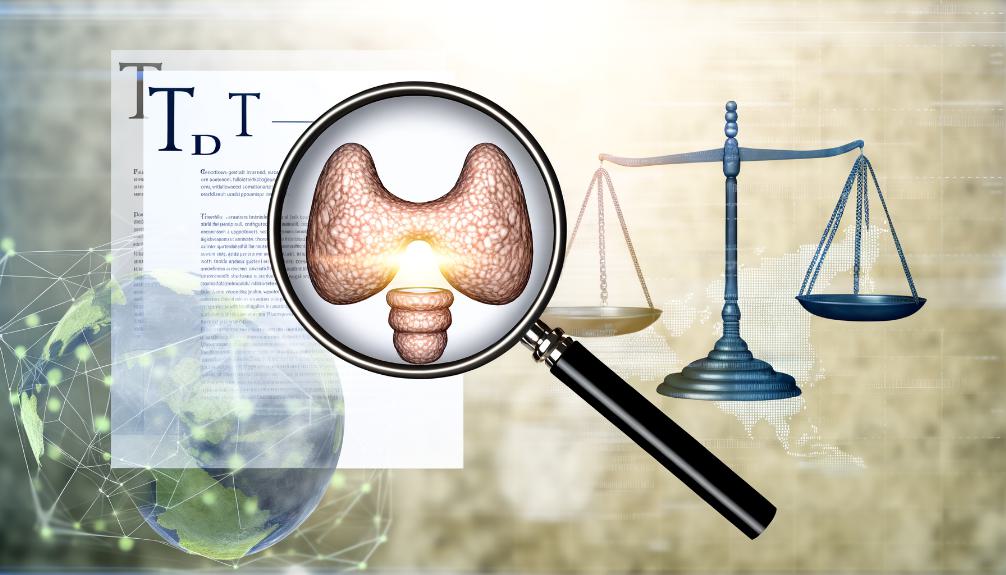
Connecting with experienced attorneys is essential for those impacted by AFFF-related thyroid issues, as they provide specialized legal guidance and support. When facing health concerns like thyroid nodules due to AFFF exposure, the path to understanding one's rights and potential for compensation can seem challenging. However, specialized attorneys, particularly those at Atraxia Law, offer a beacon of hope. They bring a wealth of knowledge in toxic exposure and personal injury claims, making them invaluable allies in maneuvering these complex legal waters.
For individuals suspecting their thyroid nodules are a consequence of AFFF exposure, seeking legal assistance is a critical step. Atraxia Law stands out for its expertise in this niche area, offering personalized support to those affected. By submitting employment and medical records, potential claimants can have their eligibility for legal action assessed, a process that Atraxia Law facilitates with precision and care.
Eligibility is a key concern for many, and rightfully so. The link between AFFF exposure and thyroid issues adds a layer of complexity to personal injury claims. Fortunately, eligible individuals who connect with Atraxia Law's specialized attorneys can navigate these challenges more effectively. The firm's focus on toxic exposure cases, including those related to AFFF and thyroid health, means they are well-equipped to guide claimants toward seeking the compensation they deserve.
For anyone grappling with thyroid nodules potentially tied to AFFF exposure, reaching out to Atraxia Law can mark the beginning of a journey toward justice and healing. Their specialized attorneys understand the intricacies of such cases, ensuring that each claimant's story is heard and validated.

This post has been generated by AI and was not reviewed by editors. This is Not legal advice. Please consult with an attorney.




